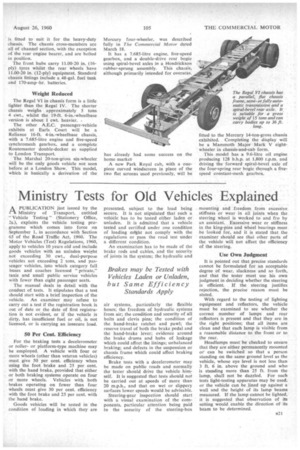Ministry Tests for Old Vehicles Explained
Page 55

If you've noticed an error in this article please click here to report it so we can fix it.
APUBLICATION just issued by the Ministry of Transport, entitled " Vehicle Testing" (Stationery Office, 2s.), explains the vehicle testing programme which comes into force on September 1, in accordance with Section 65 of the Road Traffic Act, 1960. The Motor Vehicles (Test) Regulations, 1960, apply to vehicles 10 years old and include goods vehicles with an unladen weight not exceeding 30 cwt., dual-purpose vehicles not exceeding 2 tons, and passenger vehicles, into which category fall buses and coaches licensed "private," taxis and small public service vehicles with fewer than eight passenger seats.
The manual deals in detail with the conduct of tests. It stipulates that a test should start with a brief inspection of the vehicle. An examiner may refuse to carry out a test if the registration book is out of date or the date of first registration is not evident, or if the vehicle is dirty, has insufficient fuel or oil, is not Licensed, or is carrying an insecure load.
50 Per Cent. Efficiency
For the braking tests a decelerometer or rolleror platform-type machine may be employed. A vehicle with four or more wheels (other than veteran vehicles) must give 50 per cent. efficiency when using the foot brake and 25 per cent. with the hand brake, provided that either or both braking systems operate on four or more wheels. Vehicles with both brakes operating on fewer than four wheels must give 30 per cent, efficiency with the foot brake and 25 per cent, with the hand brake.
Goods vehicles will be tested in the condition of loading in which they are
presented, subject to the load being secure. It is not stipulated that such a vehicle has to be tested either laden or unladen. It is admitted that a vehicle tested and certified under one condition of loading might not comply with the regulations or pass the road test under a different condition.
An examination has to be made of the brake rods and cables, and the security of joints in the system; the hydraulic and
air systems, particularly the flexible hoses; the freedom of hydraulic systems from air; the condition and security of all bolts and clevis pins; the condition of the hand-brake ratchet and pawl; the reserve travel of both the brake pedal and the hand-brake lever; evidence around the brake drums and hubs of leakage Which could affect the linings; unbalanced braking; and defects in the suspension or chassis frame which could affect braking efficiency.
Brake tests with a decelerometer may be made on public roads and normally the tester should drive the vehicle himself. It is suggested that tests should not be carried out at speeds of more than 20 m.p.h., and that on wet or slippery surfaces lower speeds would be advisable.
Steering-gear inspection should start with a visual examination of the components, particular attention being paid to the security of the steering-box
mounting and freedom from excessive stiffness or wear in all joints when the steering wheel is worked to and fro by an assistant. Excessive wear or stiffness in the king-pins and wheel bearings must be looked for, and it is stated that the examiner should see that other parts of the vehicle will not affect the efficiency of the steering.
Use Own Judgment
It is pointed out that precise standards cannot be formulated for an acceptable degree of wear, slackness and so forth, and that the tester must use his own judgment in deciding whether the steering is efficient. If the steering justifies rejection, the precise reason must be stated.
With regard to the testing of lighting equipment and reflectors, the vehicle must be examined to see whether the correct number of lamps and rear reflectors is present and that they are in the right positions; that all items are dean and that each lamp is visible from a reasonable distance to the front or to the rear.
Headlamps must be checked to ensure that they are either permanently mounted or can be switched so that a person standing on the same ground level as the vehicle, whose eye level is not less than 3 ft. 6 in. above the ground and who is standing more than 25 ft. from the lamp, shall •not be dazzled. For such tests light-testing apparatus may be used, or the vehicle can be lined up against a wall and the height of its lamp beams measured. If the lamp cannot be lighted, it is suggested that observation of its setting would enable the direction of its beam to be determined.




















































































































